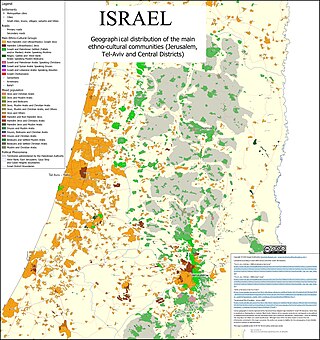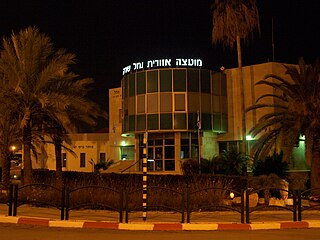
The Central District of Israel is one of six administrative districts, including most of the Sharon region. It is further divided into four sub-districts: Petah Tikva, Ramla, Sharon, and Rehovot. The district's largest city is Rishon LeZion. The district's population as of 2017 was 2,115,800. According to the Israeli Central Bureau of Statistics, 88% of the population is Jewish, 8.2% is Arab, and 4% are "non-classified", being mostly former Soviet Union immigrants of partial or nominal Jewish ethnic heritage or household members of Jews.

There are six main administrative districts of Israel, known in Hebrew as mekhozot and in Arabic as mintaqah. There are also 15 subdistricts of Israel, known in Hebrew nafot and in Arabic as qadaa. Each subdistrict is further divided into natural regions, which in turn are further divided into council-level divisions: whether they might be cities, municipalities, or regional councils.

Brenner Regional Council, is a regional council in the Central District of Israel. It is located in the westernmost portion of the Shephelah, in the vicinity of Rehovot and Yavne. The council is named after writer Yosef Haim Brenner, killed in the Jaffa riots of 1921.

Nahal Sorek Regional Council is a regional council in the Central District of Israel. The seat of the council is Yad Binyamin. The council is named for the Sorek stream.

Route 411, is the designation of a regional route in the Shephelah region in Israel running southeasterly consolidating previous local roads and new construction. The western section begins at Highway 42 near Kfar Gevirol in western Rehovot and continues just past Route 410. The central section, completed in June 2014, continues to the entrance of Kvutzat Shiller. The eastern section begins just short of Highway 40 south of Rehovot and terminates at Highway 3 towards Jerusalem, bypassing the towns of Kiryat Ekron and Mazkeret Batya.

The Ramle Subdistrict was one of the subdistricts of Mandatory Palestine. It was part of Lydda District of the British Mandate of Palestine. The sub-district's main city was Ramle. Its total population in 1944 was estimated at 123,490, of which 88,560 were Muslims; 29,420 were Jews; and 5,500 were Christians. A number of Palestinian Arab villages in the subdistrict were ethnically cleansed during the Nakba, both by Zionist forces prior to the Israeli declaration of independence and after by Israeli forces. Following the war the area that had made up Ramla Subdistrict became a part of Israel's Central District, being mostly subdivided between a newly created Ramla Subdistrict and Rehovot Subdistrict.
Weidu is a district of the city of Xuchang, Henan province, China, named for Xuchang having been the capital of the Cao Wei (曹魏) state furing the Three Kingdom era.
The Safed subdistrict is one of Israel's sub-districts in the Northern District. As the name suggests, the main settlement is the town of Safed.
The Kinneret Subdistrict is one of the subdistricts of Israel's Northern District. The largest city and the centre of the subdistrict is the city of Tiberias on the western coast of the Sea of Galilee.
The Jezreel Subdistrict is one of Israel's sub-districts in Northern District.
The Acre Subdistrict, alternatively spelt as Akko Subdistrict or Akka Subdistrict, is one of Israel's sub-districts in the Northern District.
The Haifa Subdistrict is one of Israel's sub-districts in Haifa District. The Subdistrict is composed of mostly of the Northern half of the historical Mandatory Haifa Subdistrict.
The Hadera subdistrict is one of Israel's subdistricts in Haifa District. The district is composed of mostly of the Southern half of Mandatory Haifa Subdistrict.
The Golan Subdistrict is an area administered by Israel as a subdistrict of Northern District. The subdistrict encompasses the Israeli-occupied territories of Golan Heights, occupied from Syria during the Six-day war and annexed to Israel under the Golan Heights Law. Thus this region is internationally recognized to encompass Quneitra Governorate, which itself is composed of 2 districts and 5 subdistricts.
The HaSharon Subdistrict is one of Israel's subdistricts in the Central District. The principal city of this subdistrict is Netanya. The subdistrict is situated in the Sharon plain, a section of Israel's coastal plain, from which it draws its name.
The Petah Tikva Subdistrict is one of Israel's subdistricts in the Central District. The principal city of this subdistrict, as the name implies, is Petah Tikva.
The Ramla subdistrict is one of Israel's subdistricts in the Central District. There are three principal cities in the subdistrict: Ramla, Lod, and Modi'in-Maccabim-Re'ut.
The Ashkelon Subdistrict is the northern of the two sub-districts in Israel's Southern District. Its population is more than half a million. It is an important region for manufacturing including electricity production and water desalination, agriculture, transportation, tourism, and trade.
The Beersheba Subdistrict is the southernmost subdistrict of Israel and one of two subdistricts in its Southern District. The capital of the subdistrict is, as the name implies, Beersheba. Rahat is the second-largest city and Eilat comes third. Other cities in the subdistrict are Arad, Dimona, Netivot, and Ofakim. Hura and Kseifa have not received city status yet are of similar size. The subdistrict includes an international airport, near Eilat, and a seaport in Eilat.






